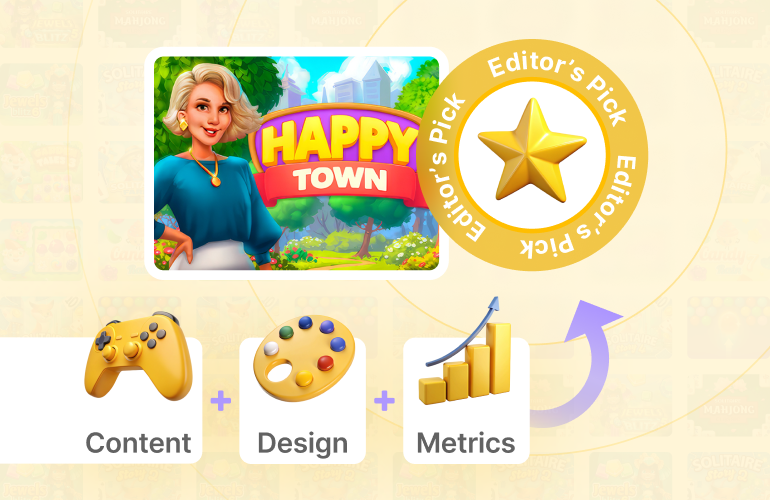Being featured as an Editor’s Pick is one of the most effective ways to increase a game’s visibility and reach a global network of publishers. Moreover, for developers aiming to grow on mobile or desktop platforms, this curated spotlight can significantly accelerate exposure and engagement.
To shed light on the process, GameDistribution’s Head of Content, Calvin Man, shares what the content team looks for and how developers can improve their chances of being featured.
What Is an Editor’s Pick?
Each week, the GameDistribution content team selects 10 standout games and features them across its global network
Editor’s Picks give all developers, from indie creators to larger studios, the opportunity to shine. In other words, titles that excel in gameplay and performance have a strong chance, regardless of their background.
As a result, being selected as an Editor’s Pick offers significant value. In particular, featured games enjoy front-row exposure to publishers. Consequently, this often leads to faster discovery across the catalog.
Editor Selection Criteria
The team reviews four key performance indicators (KPIs):
- Revenue Performance
- Gameplay
- Ad Score
- Average Session Length (referred to as Engagement Score)
Following this evaluation, the team collaborates to finalize the selection. The goal is to support both the business and creative goals of GameDistribution’s ecosystem.
“It’s always a win-win-win. Therefore, we choose games that perform for developers, deliver for publishers, and strengthen GameDistribution’s platform,” Calvin explains.
Understand the KPIs, Then Focus on the Content
As Calvin puts it, performance data is just the beginning.
“When you know the KPI, you know where to leverage your efforts. Even so, the most important thing for long-term success is to improve the content.”
A strong game performs well but only if it gets noticed. Too often, developers focus heavily on mechanics while overlooking presentation, which is just as crucial for discovery. Therefore, both gameplay and visual design must work together from the start.
Game’s First Impression
Even the best gameplay loop and onboarding mean little if no one clicks on the game. Without strong initial visibility, it’s hard to generate the performance data needed for selection.
“Indeed, one of the most underrated factors is your game title and thumbnail,” says Calvin. “It’s not just about attracting players. After all, it’s also about catching the attention of our content team and publishers”
Every game submitted to GameDistribution undergoes internal review and testing. In fact, a strong title or thumbnail is recommended, as it can help a game stand out in the queue and potentially accelerate the release process. As such, developers should invest time in optimizing visual elements before submission.

Top Traits of High-Performing Games
Based on GameDistribution’s editorial experience, here are common traits of selected titles:
✅ Be Eye-Catching
Create a visually appealing thumbnail and title to grab players’ attention.
✅ Deliver Strong Gameplay
Engaging games lead to longer sessions and higher scores.
✅ Use Keywords Wisely
Effective keyword optimization improves discoverability.
✅ Be Timely
Seasonal themes can help a title shine in a crowded feed.
✅ Stay Relevant with Trends
Aligning with industry trends can increase a game’s chances of getting noticed. For example, Merge2 and Merge3 are performing well on GameDistribution, just as they are on mobile storefronts.
For more trend insights, subscribe to the newsletter.
✅ Feature Recognizable Elements
Characters or settings tied to pop culture can boost interest and engagement (such as the newly released Minecraft movie)
✅ Even a Refreshed Classic Can Win
A polished re-release can compete with fresh concepts if executed well.
Ultimately, session length remains a key indicator of performance. In many cases, longer sessions lead to higher engagement, better monetization, and more sustainable growth.
Tracking and Improving Your Game’s KPIs
Developers can access all key performance metrics via the GameDistribution Developer Panel:
- Gameplay Score
- Ad Score
- Average Engagement Score
To review performance, go to the Developer Panel, select a game, and compare its KPIs with genre averages. Additionally, for a deeper look at monetization, the Headerlift report offers detailed revenue insights.
📊 Even better, this analytics suite is completely free. Consequently, developers can grow their games without relying on paid user acquisition.
Examples of Editor’s Pick in Action
The content team selects games based entirely on data, typically ensuring titles meet at least two of the following criteria:
- Studio Highlights
In-house releases that consistently deliver strong engagement. For instance, Bubble Shooter Panda Blast, Traffic Tap Puzzle
- Top Performers
Titles excelling in revenue and gameplay metrics, such as Heritage Mahjong Classic - High Growth Potential
Games with strong Ad Score and longer session length often show early signs of success. Examples include FNF 2 Player, Happy Town, Fill One Line, Robbie: Become a Beast
In conclusion, selection as an Editor’s Pick doesn’t come down to luck. Instead, success comes from understanding KPIs, compelling presentation, and consistently high-performing content. When both gameplay and presentation are strong, a game naturally rises to the top.






